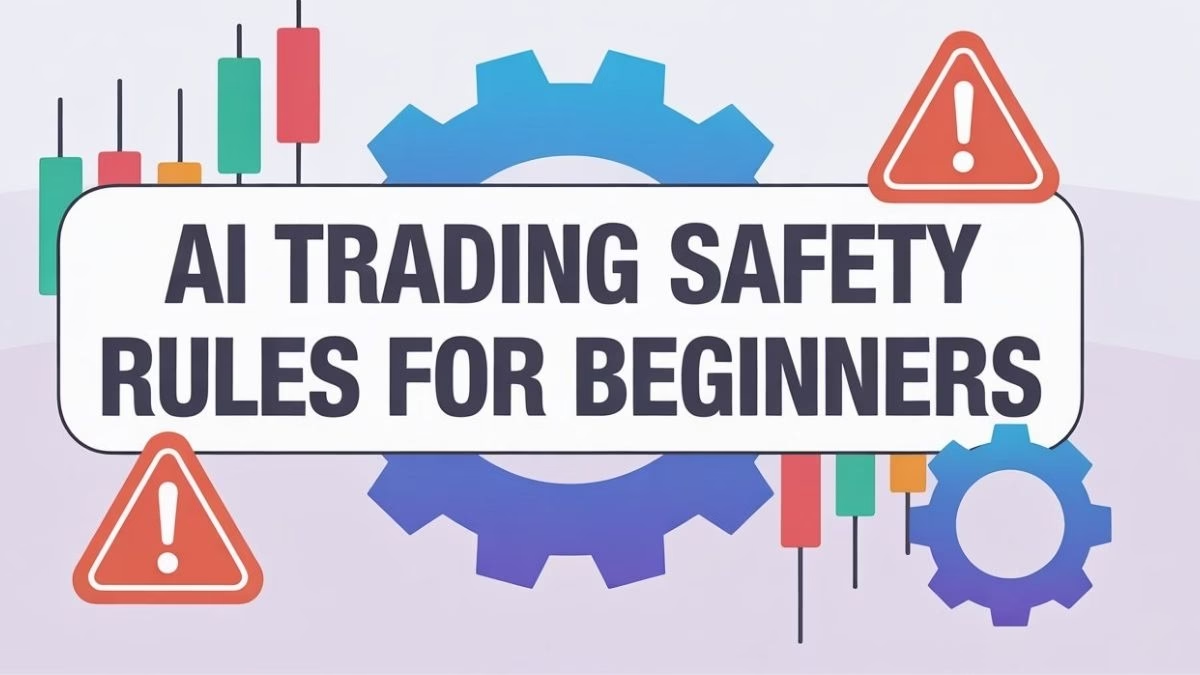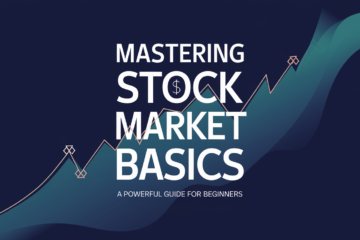AI trading tools look exciting on the surface. Screens show perfect backtests, smooth curves, and confident marketing promises that seem built for new traders. Social feeds fill with profit screenshots that make automation look effortless. Every chart and dashboard seems to suggest that software will handle the hardest decisions for you, yet real safety still depends on clear AI trading safety rules for beginners.
Can this really help without draining savings? How can someone new to markets feel safe with automation? This guide walks through clear AI trading safety rules for beginners so capital stays protected while you still use modern tools with confidence.
Why AI Trading Safety Rules for Beginners Matter
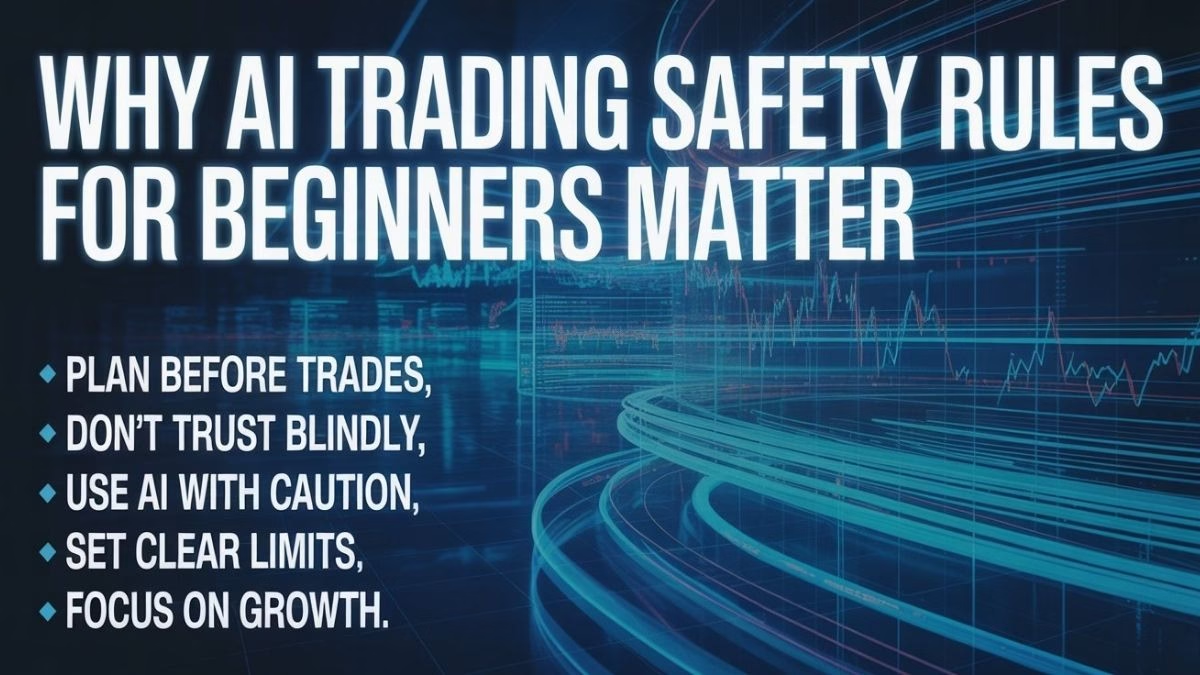
AI reads charts faster than any human. However, every order still connects to real money, real emotions, and real goals. That reality makes safety rules more important than any indicator or strategy label.
- First, many beginners copy trades from social media without a written plan. As a result, position sizes often match another person’s risk tolerance instead of personal comfort or timelines.
- Second, research from the CFA Institute on AI and big data in investment management shows that professional firms combine AI with human oversight rather than relying on blind trust, which aligns with retail traders as well.
- When someone still feels shaky with simple terms such as orders, trends, and position sizes, this detailed guide on mastering stock market basics for beginners gives a calmer foundation before they plug AI tools into live capital.
- In addition, regulatory discussions on algorithmic trading keep returning to the same idea. Automation requires clear controls, defined limits, and regular reviews so accounts stay safe when volatility rises.
- Overall, safety rules soften the mental pressure around trading. Smaller risk, structured routines, and transparent processes reduce panic, which helps beginners continue learning after tough weeks instead of walking away.
Rule 1: Fix Your Risk Per Trade Before Any Signal
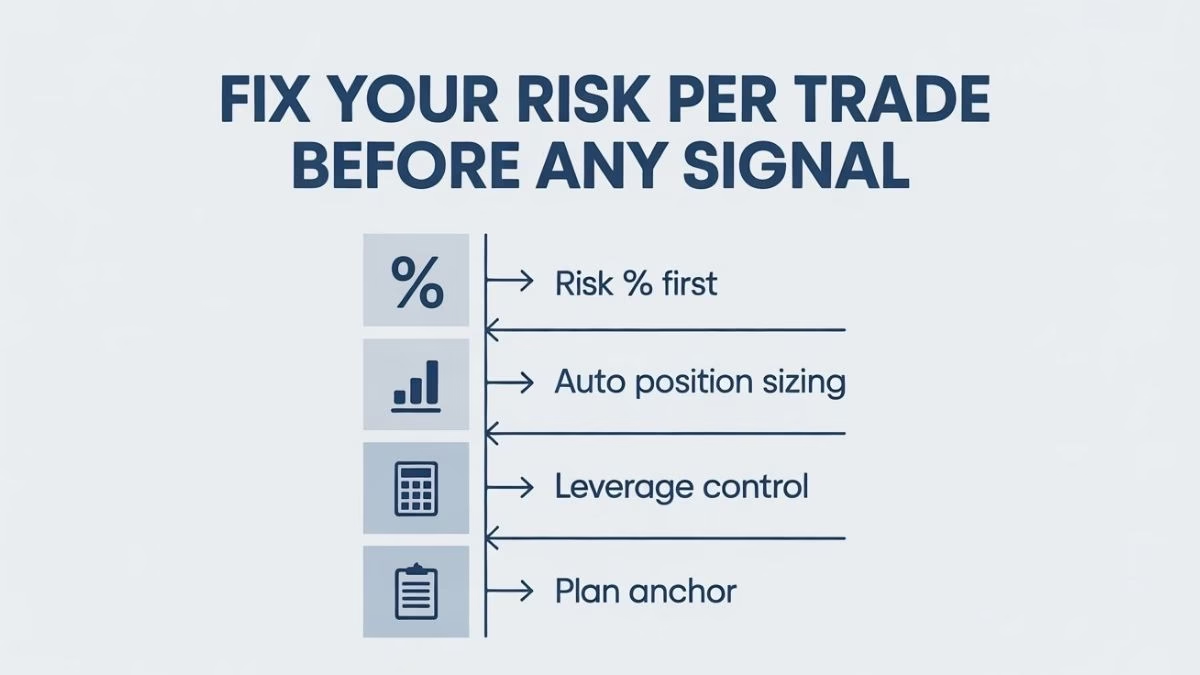
Before any bot activates, one number sits at the center. How much of the account can a single trade lose? This simple choice supports every other part of AI trading safety rules for beginners and keeps damage contained.
- For example, guides such as Investopedia – position sizing explain how risking around 1% or 2% of total capital per trade helps accounts survive strings of losing trades.
- Therefore, a fixed percentage risk makes position sizing easier. As account size changes, position size adjusts while the percentage stays constant, which keeps risk proportional rather than random.
- Next, this rule guides decisions about leverage. When brokers offer margin, a fixed risk cap stops beginners from opening oversized AI-driven positions across several correlated instruments at the same time.
- Finally, writing the percentage into a short trading plan keeps behaviour honest. Whenever an AI signal appears, traders quickly check the proposed size against that rule before pressing the confirm button.
Rule 2: Use a Simple 30% Guardrail for AI
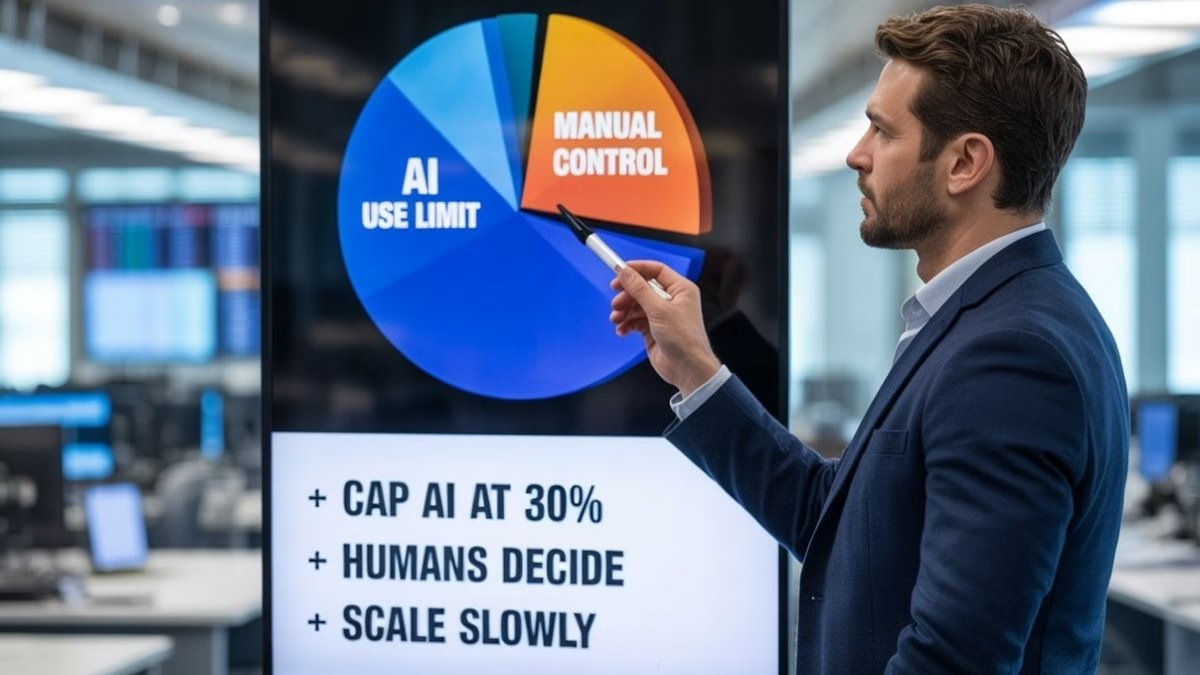
Many people ask what a “30 % rule” in AI could look like. Instead of chasing jargon, a practical approach treats 30% as an upper boundary for how much capital and decision power AI receives.
- To start, beginners can limit AI-driven positions to roughly 30% of total trading capital. The remaining funds stay in cash or safer instruments while early experiments run in controlled conditions.
- At the same time, decision-making power can follow that idea. AI suggests entries and exits, yet humans still define goals, watchlists, and risk limits, so algorithms never control every part of the process.
- Similarly, the Smart Ring Trend 2025 guide shows how small wearables quietly collect data while people stay in charge of what to track and how to respond.
- In addition, policy work such as OECD – AI in finance highlights both opportunities and systemic risks when automation spreads, which reinforces the value of such guardrails.
- Later, as months of experience and data build trust, traders can adjust this cap slowly. Gradual changes feel safer than sudden leaps from tiny tests to full automation across the whole account.
Rule 3: A 3-5-7 Rule for Testing AI Systems
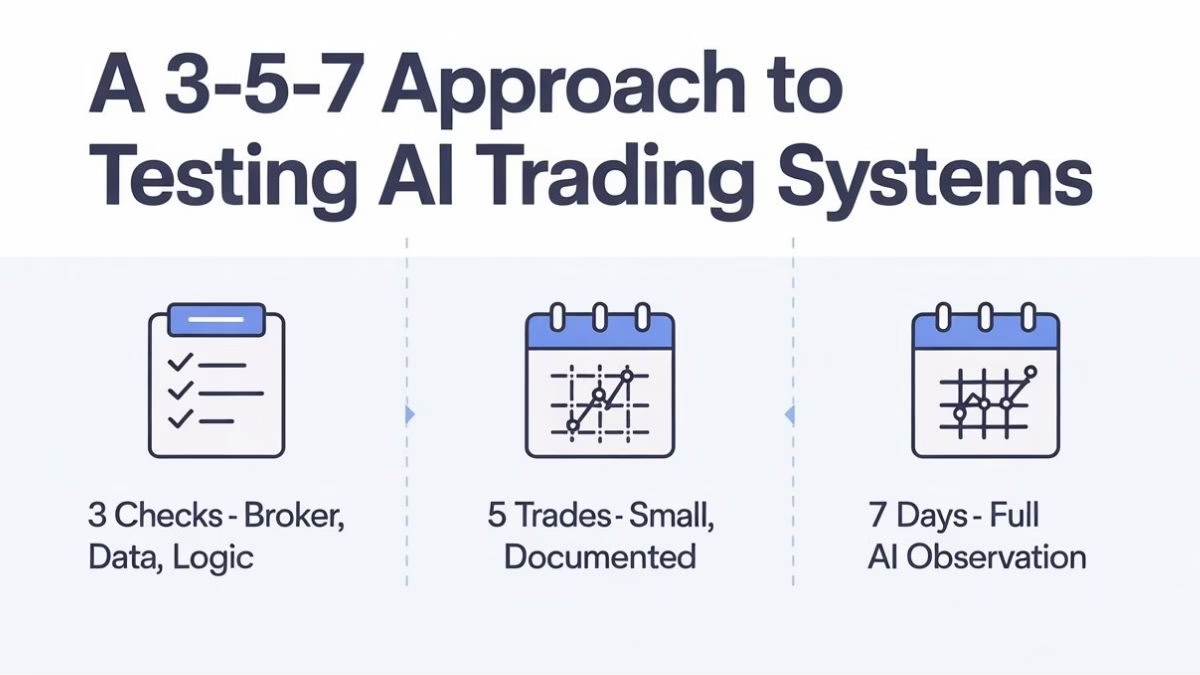
Questions about a “3 5 7 rule in trading” often appear when people talk about AI testing. In this guide, the idea works as a patient checklist that slows everything down before serious money touches any automated setup.
- The first step covers three checks. Traders confirm broker safety, data quality, and basic strategy logic. Whenever one of these fails, AI trading pauses until the issue receives a clear, documented fix.
- The second step involves five tiny live trades. Each trade uses a very small size, a screenshot, and a short journal note, which reveals slippage, delays, and emotional reactions that paper trading can easily hide.
- The third step spans seven days of journaling. During this period, traders watch how AI behaves during trends, quiet sessions, and choppy markets, so strengths and weaknesses become easier to spot.
- Overall, this 3-5-7 rhythm encourages patience. Instead of jumping straight from backtests to large positions, beginners move through clear checkpoints with time to think at every single stage.
On a related note, the Neuromarketing Techniques Marketers Need in 2026 guide shows how subtle cues and layouts push people into rushed decisions and can tempt traders to ignore their 3-5-7 rule.
Rule 4: Five Core AI Trading Safety Rules for Beginners

Many traders like one simple list of rules. When people ask about the five rules of AI trading safety, this compact set covers the essentials and works well taped near a screen or written in a trading journal.
- The first rule protects capital. The plan defines risk per trade, daily loss limits, and a maximum drawdown, where all new AI trades stop immediately until a complete review takes place.
- The second rule demands clean data. Work such as the BIS working paper on machine learning in finance shows how weak or biased data leads to fragile models and unreliable signals.
- The third rule keeps manual kill switches ready. Traders always maintain a simple way to block all new AI entries when markets act strangely, platforms glitch, or personal stress levels rise too high.
- Fourth and fifth rules focus on review and simplicity. Regular performance checks remove weak ideas, and beginners avoid stacking too many AI strategies or indicators onto small accounts at the same time.
How to Use AI in Trading for Beginners

Many beginners want to know how to use AI in trading without feeling lost. A calm approach treats AI as an assistant that handles scanning and measurement while humans keep control over direction, limits, and emotional balance.
- For instance, beginners can start by using AI purely for research. Pattern recognition, watchlist building, and scenario tests carry less risk than full automation on the very first day.
- Next, those insights feed simple decisions. Articles like AI-Powered Trading Strategies 2026: Smarter Market Wins show how AI tools filter noise and highlight practical setups instead of random entries.
- Then, demo or paper trading accounts give a safe practice space. AI runs on live data, yet orders stay virtual while traders learn how latency, slippage, and signal frequency feel in real conditions.
- Later, once results look steady, and rules stay clear, traders can move to small live sizes. Gradual increases follow months of consistent performance rather than one lucky run.
Build a Calm Human Plus AI Trading Routine
Even strict rules fail when daily routines stay chaotic. A calm human plus AI workflow protects attention, reduces overtrading, and supports steady learning, which suits beginners and experienced traders alike.
- Each morning, AI dashboards can summarize markets. Heatmaps, watchlists, and alerts for key levels replace random scrolling and give structure before the trading session starts.
- During trading hours, alerts highlight situations that match personal rules. Consequently, beginners can step away from screens until those conditions appear, which reduces emotional impulse trades and fatigue.
- After the close, a short review helps. Screenshots, notes on feelings, and basic stats from the AI platform show where rules held firm and where fear or greed took control.
- On weekends, a deeper review across many days reveals patterns. This moment also works well for revisiting Quantum Trading Strategies 2026: What Traders Must Know and connecting daily behavior with broader scenario planning ideas.
Conclusion: Your Next Step with AI Trading Safety
Safe AI trading grows through steady practice rather than dramatic shortcuts. The focus stays on capital first, tools second. Over time, AI trading safety rules for beginners help trading feel like a learnable skill instead of a guess.
External guidance from regulators such as ESMA – Article 17 on algorithmic trading and the SEBI report on participation of retail investors in algorithmic trading reinforces that message about controls. Meanwhile, educational sources like Investopedia, CFA Institute, and OECD – AI in finance deepen understanding of risk and automation.
When that outside knowledge connects with internal content on AI trading, quantum strategies, and modern tech, beginners receive a path that truly supports long-term growth.
Start by picking one rule from this guide and applying it to your very next trade. Then, when these AI trading safety rules for beginners feel natural, open your AI-powered trading strategies guide, and let your safer setup explore smarter ideas.
FAQs
How should a beginner start using AI in trading?
Beginners can start with AI tools for scanning, alerts, and simple analysis. Demo accounts, tiny test positions, and a written risk plan create a safe sandbox before meaningful capital enters live trades.
What is a 30% style rule in AI trading?
A 30% style rule limits AI to a support role. Traders cap AI-driven capital and decisions at roughly one third of the whole process, so human judgment still shapes direction and risk.
What does the 3-5-7 rule mean?
The 3-5-7 rule means three safety checks, five tiny live trades, and seven days of journaling. This structure slows beginners down and encourages careful testing before scaling position size.
What are the 5 main rules of safe AI trading?
Five key rules include fixed risk per trade, clean data, manual kill switches, regular performance reviews, and simple strategies. Together, these rules protect capital while skills and confidence grow steadily.
Can AI trading really work for complete beginners?
AI trading can support beginners when they use clear rules, patient testing, and a small size. It works best as a learning companion that reduces noise rather than a shortcut to fast profits.
Which platforms work best for safe AI trading?
Useful platforms offer transparent fees, strong risk controls, and solid education sections. External reviews, regulatory news, and broker resources help confirm that a platform treats risk management seriously.
How important is position sizing in AI trading?
Position sizing remains crucial. Small, consistent risk per trade, guided by Investopedia’s position sizing articles, keeps losses survivable when models hit inevitable losing streaks in volatile markets.
Should beginners automate entries and exits right away?
Beginners often do better when they automate gradually. AI can suggest entries while traders manage exits manually, which keeps emotional awareness and responsibility close to every decision.
How often should AI systems be reviewed?
Regular reviews work best. Weekly statistics, monthly parameter checks, and occasional deep audits help confirm that AI systems still match current markets instead of stale backtests or past assumptions.
What mindset helps beginners succeed with AI trading?
A patient, experiment-focused mindset helps most. Traders who protect capital, review every outcome, and give their process time usually feel calmer and build stronger long-term skills with AI tools.

